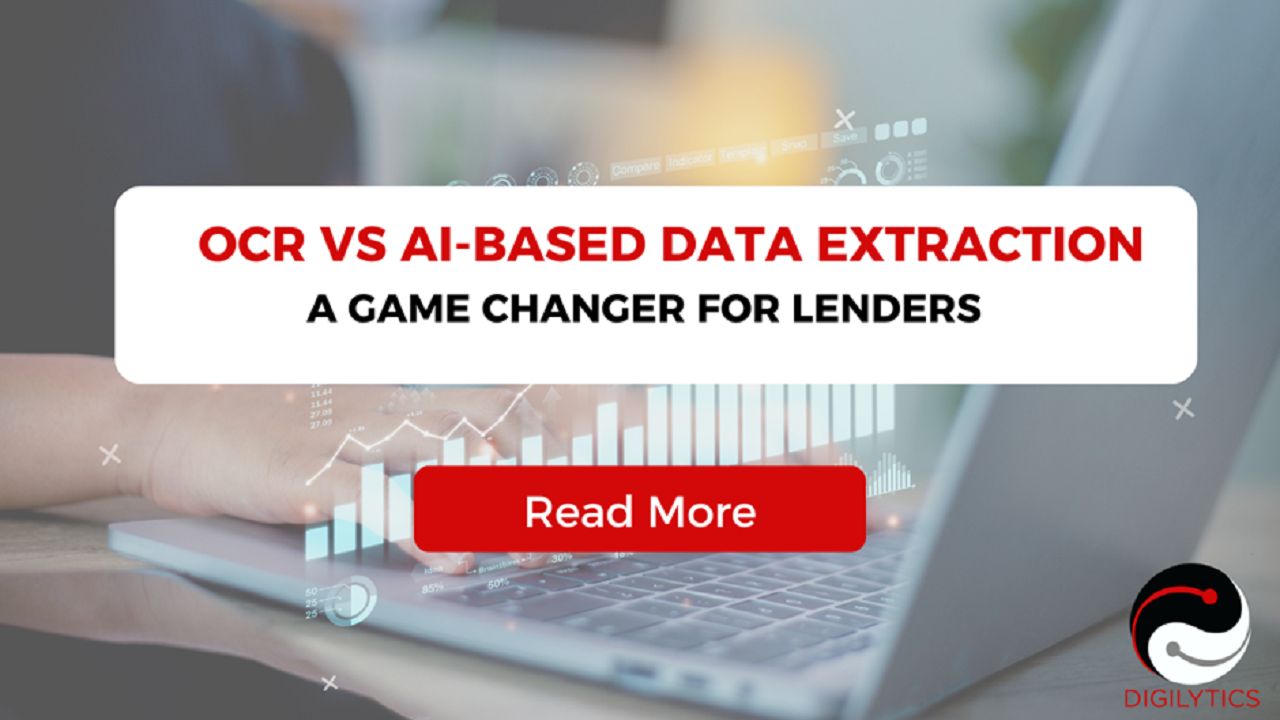OCR vs AI-Based Data Extraction | A Game Changer for Lenders
Introduction
In today’s fast-paced lending environment, efficiency and accuracy are paramount. As financial institutions increasingly digitize their processes, the choice between traditional Optical Character Recognition (OCR) and advanced AI-based data extraction has become a critical consideration. In this blog, we’ll explore the differences between these two technologies and why AI-based data extraction is revolutionizing the lending industry.
What is OCR?
Optical Character Recognition (OCR) is a technology that converts different types of documents, such as scanned paper documents or PDFs, into editable and searchable data. While OCR has been a staple in document processing, it has limitations that make it less suitable for the complex needs of the lending industry.
Limitations of OCR in Lending
- 1. Document Variety: Lenders handle numerous document types—application forms, tax returns, bank statements—each with unique formats. OCR often struggles with inconsistent layouts, leading to inaccuracies.
- 2. Handwritten Content: Many documents include handwritten notes or signatures, which traditional OCR typically cannot read accurately, resulting in lost or misinterpreted information.
- 3. Image Quality Issues: Scanned documents may be low-quality, blurred, or distorted, negatively impacting OCR’s ability to extract text correctly.
- 4. Complex Data Needs: Extracting specific data points (like income or loan terms) from documents often requires a level of understanding and context that traditional OCR lacks, resulting in incomplete or erroneous data extraction.
- 5. Contextual Relationships: OCR focuses on recognizing text without understanding the relationships or context between different pieces of information, which is crucial for effective decision-making in lending.
- 6. Compliance Requirements: Lenders must adhere to strict regulatory standards. Traditional OCR may not provide the necessary checks and balances to ensure compliance, risking potential legal issues.
- 7. Language and Terminology: Financial documents often contain industry-specific jargon, acronyms, and varied language that traditional OCR may not handle well, leading to further inaccuracies.
These factors make OCR less effective in the lending industry compared to more advanced solutions that can handle complexity, variability, and contextual understanding.
Enter AI-Based Data Extraction
AI-based data extraction takes a more sophisticated approach. Leveraging machine learning and natural language processing, these systems can not only read text but also understand context and relationships within the data.
Advantages of AI-Based Data Extraction
- 1. Accuracy with Context: Traditional OCR primarily converts images of text into machine-readable text. It often struggles with varying fonts, handwritten text, or poor image quality. In contrast, AI-based data extraction can understand context, relationships, and semantics, leading to more accurate and meaningful data extraction.
- 2. Structured vs. Unstructured Data: OCR usually deals with structured data, like printed documents. AI can handle unstructured data more effectively, analysing complex formats, extracting relevant information, and recognizing patterns that OCR might miss.
- 3. Machine Learning Adaptability: AI models can be trained on specific datasets to improve their accuracy over time, adapting to different types of documents and nuances in language. Traditional OCR systems often lack this adaptability and may require manual adjustments for different use cases.
- 4. Error Correction and Post-Processing: AI-based systems can include advanced error-correction algorithms that enhance data quality after extraction, while OCR might produce raw text that requires significant post-processing to achieve similar quality.
- 5. Multi-modal Capabilities: AI can integrate information from multiple sources, such as images, text, and even audio, enabling more comprehensive data extraction and analysis that goes beyond the limitations of OCR.
Real-World Impact
Many lenders are now adopting AI-based data extraction technologies. For example, companies that have implemented AI-driven solutions report reduced processing times and improved loan approval rates. By minimizing manual intervention, lenders can focus more on strategic decision-making rather than data entry.
Conclusion
While traditional OCR has its merits, the evolving landscape of the lending industry necessitates more advanced solutions. AI-based data extraction not only addresses the limitations of OCR but also offers a host of benefits that enhance efficiency, accuracy, and compliance. As lenders continue to embrace digital transformation, adopting AI-driven technologies will be key to staying competitive in the market.
While you are here, other top articles you might be interested in
Role of AI in SME loan origination Verifying Information in Mortgage Lending Process: Supporting Documents vs. Data Sources? All about One-shot Learning AI technology and its impact on the UK Mortgage Market A change in technology is coming to the UK Mortgage 3C checks: The Digilytics Art of validating mortgage documents The Future of Computer Vision, Machine Learning and Artificial Intelligence in Mortgage Industry How industry 4.0 principles can work in the favor of mortgage origination? Top 5 Real Challenges in Building Predictive Models in Mortgages 5 Ways in which Mortgage Lenders can Leverage Digital Lending for Good- + Accelerating Time to Offer in Mortgage Industry
- + Intelligent Affordability Service
- + Applying industry 4.0 principles to mortgage origination
- + Leveraging AI to move to the next level of digitization in mortgages
- + Intelligent Data Capture
- + Sell Different Sell More
- + Making Insights Actionable
- + Harnessing your data assets

